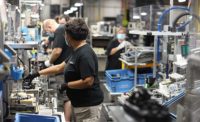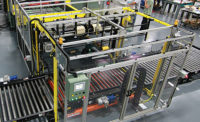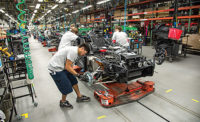With the calendar turning to December and the countdown to 2024 almost upon us, I wanted to recap my articles from the past year and their key takeaways. With a strong outlook for manufacturing next year, these takeaways can help position your company for a successful new year.
1. Skilled Workforce Development: What Should Guidance Counselors Tell Students?
The current system is failing many of our youth and failing to provide the workforce our country needs. The Fourth Industrial Revolution is transforming work at an unparalleled pace due to new technologies like artificial intelligence, robotics, automation and the Internet of Things. If a “college for all” strategy is no longer working, what should guidance counselors tell students?
Key takeaway: The career you prepare for is the most important factor in deciding on the value of a degree. Workers with two-year degrees (or an apprenticeship) can out-earn graduates of four-year universities who go into less lucrative fields.
2. U.S. Manufacturing Has Stabilized And Poised for Growth
Current manufacturing employment is about 6 million higher than one would have predicted in 2008. The exciting trend of the past 12 years is largely due to less offshoring and more reshoring and foreign direct investment. Manufacturing has stabilized, and it is time for more dramatic growth as reshoring surges.
Key takeaway: Actions that enable domestic production and reindustrialization are highly feasible. Read the article and learn what actions the U.S. should take to commit to closing the cost gap over the next 20 years.
3. The Case for Returning U.S. Manufacturing from China
Sourcing from China is increasingly risky. Geopolitical risk is now the leading driver of reshoring. Ongoing events in the Middle East, Ukraine and Taiwan suggest that reshoring will continue to accelerate. Compared to China, domestic sourcing is free from geopolitical risk for American firms, and in many cases, domestic sourcing is more cost-effective.
Key takeaway: Learn about the risks and declining opportunities of sourcing in China and the risk estimates for other key trading partners. Discover the impact of using total cost of ownership instead of the free on board price, 30 percent of products are more profitably sourced domestically. If a 25 percent Section 301 tariff applies, that sourcing proportion rises to 50 percent.
4. Manufacturing Projects for EV Batteries and Semiconductors Catapult Reshoring
A surge in manufacturing projects for EV batteries and semiconductor chips—combined with the continuing trend of reshoring across a broad range of industries—is helping to propel current and future manufacturing jobs to record highs.
New investments in U.S. manufacturing by domestic and foreign companies surged after President Biden’s Inflation Reduction Act (IRA) and Chips and Science Act were passed.
Key takeaway: These programs are meant to target long-term comprehensive economic development and job creation by supporting business and workforce development in areas where the U.S. is overdependent on imports. Can your company be part of these manufacturing ecosystems?
5. Reshoring Fuels U.S. Factory Construction Boom
A recent briefing from the U.S. Department of the Treasury reviews the reasons behind the “doubling of real manufacturing construction spending since the end of 2021 and…the near quadrupling of real construction spending on computer, electronics and electrical manufacturing.” The investment and manufacturing construction phenomenon in the U.S. is unlike anything seen in decades or occurring now in other countries.
Key takeaway: Learn what has reduced the total cost gap between Asian production and localization to almost zero, including both reshoring to the U.S. and nearshoring to Mexico and Canada.
6. Reshoring Confirmed: Paradigm Shift from Global to Local
The geographic distribution of global suppliers will fundamentally shift from being mostly global to mostly local by 2026 due to economic and geopolitical instability.
Over the past several years, numerous surveys of manufacturing CEOs have revealed a willingness to reshore some or all production from overseas. Now, for the first time, we have evidence that those manufacturers are actually following through on their plans. Our analysis of multiple surveys indicates that as much as 91 percent of U.S. manufacturers have reshored some production in 2022, up from just 7 percent 2012. That result correlates with Reshoring Initiative’s own data on manufacturing job growth in the U.S. over that same time period.
Key takeaway: Read the article to find out why reshoring has been thrust into overdrive. Can your company be a part of it?
Are you thinking about reshoring? For help, contact me at 847-867-1144 or email me at harry.moser@reshorenow.org. Our main mission is to get companies to do the math correctly using our free online TCO Estimator. By using TCO, companies can better evaluate sourcing, identify alternatives, and even make a case when selling against offshore competitors.




